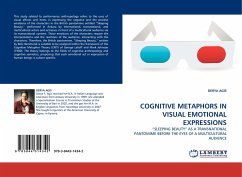This study related to performance anthropology refers to the uses of visual effects and items in expressing the negative and the positive emotions of the characters in the British pantomime entitled Sleeping Beauty, performed in Ankara by international, transnational, and multicultural actors and actresses in front of a multicultural audience via its transnational content. These emotions of the characters require the interpretations and the reactions of the audience, interacting with the characters. Therefore, the British pantomime, Sleeping Beauty, written by Bob Hammond is suitable to be analyzed within the framework of the Cognitive Metaphor Theory (CMT) of George Lakoff and Mark Johnson (1980). The theory belongs to the fields of cognitive anthropology and cognitive semiotics, proposing that each emotional act or expression of human beings is culture-specific.
Bitte wählen Sie Ihr Anliegen aus.
Rechnungen
Retourenschein anfordern
Bestellstatus
Storno








